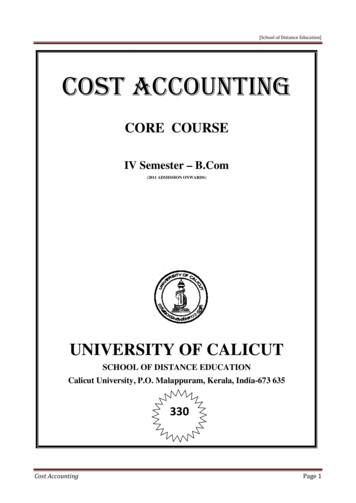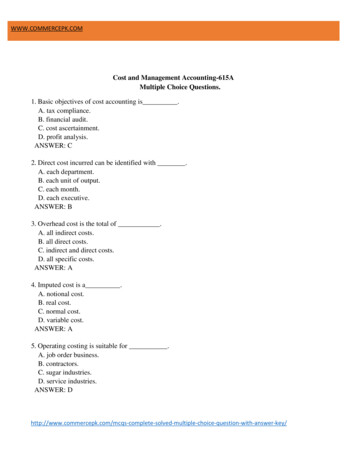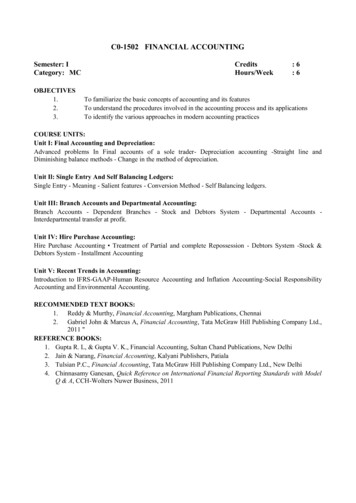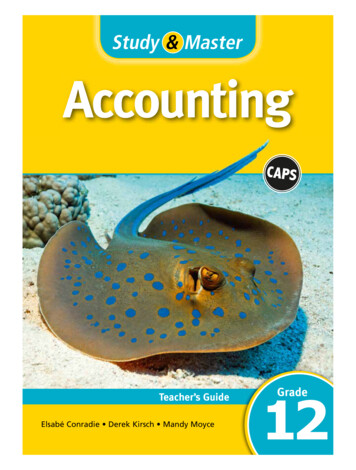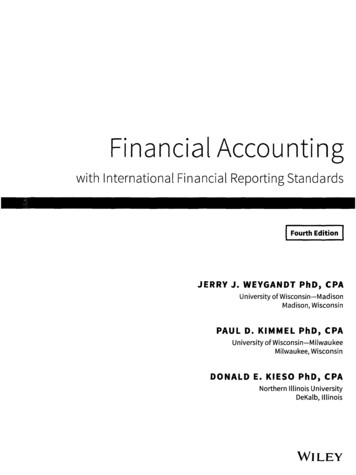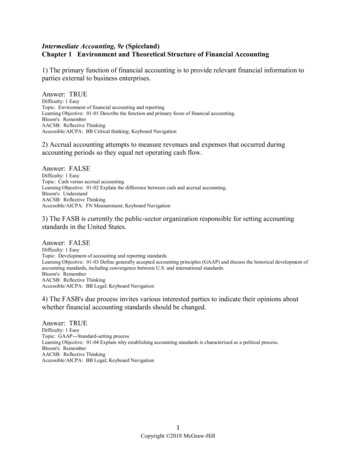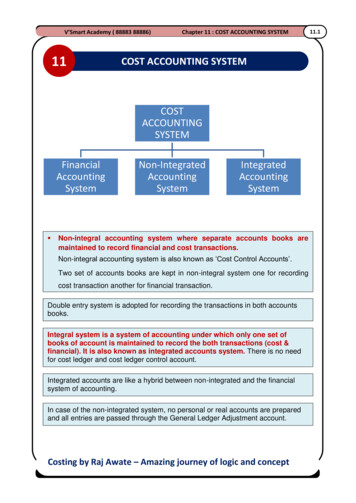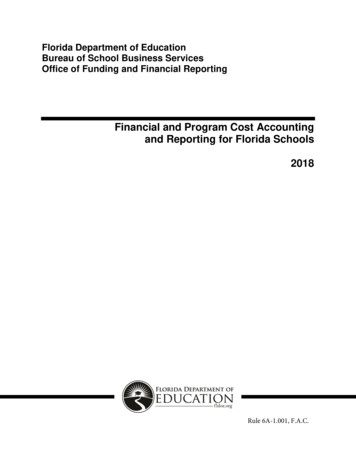
Transcription
Florida Department of EducationBureau of School Business ServicesOffice of Funding and Financial ReportingFinancial and Program Cost Accountingand Reporting for Florida Schools2018Rule 6A-1.001, F.A.C.
TABLE OF CONTENTSChapter 1IntroductionChapter 2Asset, Liability, Deferred Outflow and Inflow, Fund Balance and Net Position AccountsChapter 3Revenue AccountsChapter 4Fund Structure and Expenditure AccountsChapter 5Program Cost Accounting and ReportingChapter 6Internal Service FundsChapter 7Fiduciary FundsChapter 8School Internal FundsAppendix ASupplies and Equipment CriteriaAppendix BOptional Object Codesi
Chapter 1IntroductionThe primary purpose of this manual is to provide Florida school districts and charter schools with auniform chart of accounts for financial, cost and budgetary reporting. This manual is also the basis forgrant budgeting and reporting. For more information on reporting for grants, please see the FloridaDepartment of Education’s Project Application and Amendment Procedures for Federal and StatePrograms (Green Book) at ment-procedur.stml.Generally accepted governmental accounting standards, program cost accounting and reporting, andschool internal funds are addressed in this manual. This document is incorporated by reference in rule6A-1.001, Florida Administrative Code, pursuant to the requirements of sections 1010.01, 1010.20 and1011.07, Florida Statutes.The Florida chart of accounts included in this manual is adapted from the United States Department ofEducation publication, Financial Accounting for Local and State School Systems, which establishes acomprehensive and uniform structure for reporting education fiscal data. The state chart of accounts wasmodified following the initial publication of the federal manual in 1957 and its major revision in 1973.Subsequent federal revisions in 1980, 1990, 2003, 2009 and 2014 have also been incorporated into thestate chart of accounts to ensure compatibility with national statistical reports.OVERVIEWThis section presents a brief overview of the accounting structure, including fund, revenue andexpenditure classifications.Funds are defined as fiscal and accounting entities with self-balancing sets of accounts. They recordchanges in cash and other financial resources, together with all related liabilities and residual equities orbalances. Funds are segregated for the purpose of carrying on specific activities or attaining certainobjectives in accordance with special regulations, restrictions or limitations (National Council onGovernmental Accounting Statement 1, ¶2). The basic fund structure for Florida school districts followsgenerally accepted accounting principles (GAAP) for governments.Governmental FundsGeneral FundSpecial Revenue FundsDebt Service FundsCapital Projects FundsPermanent FundsProprietary FundsEnterprise FundsInternal Service FundsFiduciary FundsPension (and Other Employee Benefit) Trust FundsInvestment Trust FundsPrivate-Purpose Trust FundsAgency FundsRevenues are categorized by fund, source and appropriation. Since revenues are usually determined bylaw, revenue accounts are structured by source (federal, state and local) and specific appropriation.1-1
Expenditures are categorized using the following elements:Fund (see definition above)FunctionObjectFacility (School)ProgramFiscal YearGrantProjectFunction refers to the objective or purpose of an expenditure (expense for government-wide andproprietary financial statement presentation). Functions are the activities performed to accomplishthe objectives of the organization. The activities of school districts are classified into four majorfunctional categories, as follows:Instruction. Instruction includes activities dealing directly with the teaching of students orthe interaction between teachers and students. Instruction is further classified as Basic[Florida Education Finance Program (FEFP K-12)], Exceptional Student Education,Career Education, Adult General and Other Instruction. Other Instruction includesprograms such as recreation, enrichment and prekindergarten instruction.Student and Instructional Support Services. Student and Instructional Support Servicesinclude administrative, technical and logistical support to facilitate and enhanceinstruction. Student and Instructional Support Services include Student Support Services,Instructional Media Services, Instruction and Curriculum Development Services,Instructional Staff Training Services and Instruction-Related Technology.General Support Services. General Support Services include activities associated withestablishing policy, operating schools and the school system, and providing the necessaryfacilities and services for the staff and students. This includes salaries and expendituresfor the Board, General Administration, School Administration, Facilities Acquisition andConstruction, Fiscal Services, Food Services, Central Services, Student TransportationServices, Operation of Plant, Maintenance of Plant and Administrative TechnologyServices.Community Services. Community Services are activities that are not directly related toproviding education for students in a school system. These include noninstructionalservices provided by the school system for the community.Two other functional categories are necessary to support the school district, but do not includeinstruction, instructional support or administrative activities.Debt Service. Debt Service represents payments of principal and interest to service debtand expenditures related to issuance and retirement of debt.Capital Outlay. Capital Outlay includes expenditures related to, but not limited to, theprocurement of land, the purchase of furniture and equipment, and the acquisition orconstruction of educational facilities.Object refers to the goods purchased or the services obtained. There are seven major objectcategories for expenditures provided in this manual:SalariesEmployee BenefitsPurchased ServicesEnergy ServicesMaterials and SuppliesCapital OutlayOther1-2
Facility refers to the school or office location that is the center for accumulation of costs.Program refers to activities, operations or organizational units designated to accomplish anobjective or purpose. Educational programs are established by law for Florida school districts andare the basis for the program cost accounting and reporting system (see chapter 5).Fiscal Year denotes the 12-month period to which the annual budget applies. This designation isuseful in analyzing costs of programs that extend beyond one fiscal year.Grant refers to code numbers assigned by the Florida Department of Education (FDOE) forreporting state and federal grants.Project refers to a classification that is used to identify expenditures related to a specific activity,such as a construction project or a project funded through grants.For reporting purposes, grant and project numbers are five-character codes that are designated by theFDOE. School districts may elect to crosswalk from a local coding structure to the state-designated grantand project numbers.The primary purpose of this publication is to provide a uniform chart of accounts for governmental fundfinancial and cost reporting; however, many of the asset, deferred outflow, liability and deferred inflowaccounts are only used to satisfy the minimum reporting requirements for financial statementpresentation. While the functional elements are used for reporting governmental fund expenditures, thesesame groupings are used as expenses for government-wide financial statement presentation and forreporting expenses in proprietary funds.ACCOUNTING STANDARDSGAAP for governmental entities are established by the Governmental Accounting Standards Board(GASB) and provide the foundation for financial accounting and reporting for school districts.Basis of accounting refers to when revenues, expenditures, expenses and transfers – and the related assets,deferred outflows of resources, liabilities and deferred inflows of resources – are recognized in theaccounts and reported in the financial statements. GAAP require the use of the modified accrual basis ofaccounting for governmental funds. This means that revenues are recognized when they become earned,measurable and available. “Available” means collectible within the current period or soon enoughthereafter to pay liabilities of the current period. Expenditures are generally recognized when the relatedfund liability is incurred, if measurable.Proprietary and fiduciary funds use the accrual basis of accounting. That is, revenues and expenses aregenerally recognized when they occur, regardless of the timing of the related cash flows.Florida school districts operate the following types of budgetary funds: general, special revenue, capitalprojects, debt service and permanent. As indicated above, the modified accrual basis should be used inaccounting and reporting for these funds. School districts maintaining proprietary and fiduciary fundsshould apply the accrual basis of accounting.Most grants accounted for in the special revenue funds require the expenditure of funds as the primarydeterminant of eligibility for funding. Therefore, the date of expenditure also becomes the point ofrevenue recognition for the grant.1-3
An encumbrance system that charges each purchase order, contract or salary commitment to anappropriation should be used as part of a budgetary accounting system. Transactions cease to beencumbrances when paid or canceled, or when the actual liability is recorded.GOVERNMENTAL ACCOUNTING STANDARDS BOARDThe reporting model for school districts is based on GASB Statement 34, Basic Financial Statements –and Management’s Discussion and Analysis – for State and Local Governments, and is updated throughGASB Statement 83, Certain Asset Retirement Obligations. Florida school districts may use the basicmodel for financial reporting, which includes management’s discussion and analysis (MD&A), basicfinancial statements and required supplementary information (RSI) other than the MD&A. Descriptionsof all components of the basic financial statements can be found in section 2200 of the Codification ofGovernmental Accounting and Financial Reporting Standards published by the GASB. The MD&A is a component of RSI that precedes the basic financial statements. The basic financial statements should include 1) government-wide financial statements, 2) fundfinancial statements and 3) notes to the financial statements. The government-wide financial statements report information for the government as awhole, except for its fiduciary funds. These statements reflect the economic resourcesmeasurement focus and the accrual basis of accounting. The fund financial statements for governmental, proprietary and fiduciary funds followthe government-wide financial statements. The governmental and enterprise fundfinancial statements reflect major funds and combined nonmajor funds rather than a fundtype presentation. The fiduciary and proprietary funds continue to use the economicresources measurement focus and accrual basis of accounting, while the governmentalfund financial statements are presented using the current financial resources measurementfocus and the modified accrual basis of accounting. A reconciliation is required to explainthe differences between the change in fund balances reported in the fund financialstatements and the change in net position reported in the government-wide financialstatements. The need to reconcile items arises from differences in the measurementfocuses and bases of accounting between the financial statements, and certain requiredeliminations. The notes to the financial statements are an integral part of the basic financial statementsand follow the fund financial statements.RSI (other than the MD&A) is supplementary financial information that must be presented afterthe basic financial statements and includes the following: Budgetary comparisons that include the original and final budgets for the general fundand each major special revenue fund that has a legally adopted annual budget. The current funded status of other postemployment benefit plans, as of the three mostrecent actuarial valuation dates. Notes to the RSI. For cost-sharing employers, 10-year schedules containing 1) the net pension liability andcertain related ratios, and 2) if applicable, information about statutorily or contractuallyrequired contributions, contributions to the pension plan and related ratios.1-4
Chapter 2Asset, Liability, Deferred Outflow and Inflow, Fund Balance and Net Position AccountsThis chapter provides balance sheet account numbers and related definitions.1000ASSETSAssets are resources with present service capacity that the district school board presently controls[Governmental Accounting Standards Board (GASB) Concepts Statement 4, ¶8]. The presentservice capacity of a resource that is an asset is its existing capability to enable the school districtto provide educational services. All assets should be listed in order of liquidity on the financialstatements.1100Current Assets. Current assets include cash or other assets that are reasonably expectedto be realized in cash or sold or consumed within a year.11101120Cash. All funds on deposit with an official or agent designated as custodianof cash and bank deposits. Overdrafts that show negative cash should bereported as a current liability for fund financial statement presentation.Please see Account 2125, Cash Overdraft.1111Cash-on-Demand Deposits. Deposits with fiscal agents, such ascommercial banks, for the payment of normal operatingexpenditures, subject to withdrawal by board warrant.1112Petty Cash. Cash on hand maintained for the purpose of payingsmall obligations when the issuance of a formal voucher and checkis not cost-effective.1113Cash Change Funds. Cash on hand maintained for the purpose ofproviding cash register change.1114Cash with Fiscal/Service Agents. Deposits with fiscal agents, suchas commercial banks, for the payment of matured bonds andinterest. Also, deposits with self-insurance plan agents andadvance refunding escrow deposits.1115Cash – Interest-Earning Deposits. Deposits that generate interestincome, usually stipulating the duration of the deposit and rate ofinterest.1117Cash on Hand. Currency, coins and checks received but not yetdeposited.Taxes Receivable. The uncollected portion of taxes that a governmental unithas levied and billed.1121Taxes Receivable. Taxes that were levied for the current operatingyear but remain uncollected. This account should be closed onJune 30, and amounts held by the tax collector on behalf of thedistrict school board should be recorded in Account 1220, DueFrom Other Agencies.2-1
11301140Receivables. Amounts due for goods and services and pension plancontributions.1131Accounts Receivable. Amounts due on open account from privatepersons, firms or corporations for goods and services furnished bythe school district. Accounts receivable should be netted againstuncollectible amounts.1132Pension Contributions Receivable. Pension contributions fordistrict single-employer pension plans reported in private pensiontrust funds.1139Allowance for Uncollectible Accounts Receivable (Credit). Anestimate of the uncollectible portion of accounts receivable.Due From Other Funds. Amounts due for goods or services provided by aparticular fund to another fund, or for interfund loans.1141Due From Budgetary Funds. Amounts due from one fund toanother. Separate accounts should be maintained for each interfundloan.1142Due From Internal Funds. Amounts due for advances to internalaccounts. Separate accounts should be maintained for eachadvance.1150Inventory. Materials and supplies on hand for future use in operations.Subaccounts within this category may be used to identify different types ofinventory, such as purchased and donated foods and materials.1160Investments. Securities and nonfinancial assets, held primarily for income orprofit, that have present service capacity based solely on their ability togenerate cash or to be sold to generate cash. This account does not includeassets used in school district operations. Separate accounts for each categoryof investments may be maintained.1161Investments – United States Government Securities. Securities ofthe United States Government acquired by the district school boardas authorized by statute and held for the production of income inthe form of interest.1162Investments – Section 1011.14, F.S., Loans. Amounts investedfrom proceeds of loans made pursuant to section 1011.14, FloridaStatutes (F.S.).1163Investments – SBE/COBI Bonds. State Board of Education(SBE)/Capital Outlay Bond Indebtedness (COBI) bonds issued onbehalf of school districts under Article XII, section 9 of theConstitution of the State of Florida.1164Investments – State Board of Administration. Amounts placedwith the State Board of Administration for investment.2-2
120013001165Nonfinancial Investments. Capital assets acquired with theexpectation of future income or profit. These assets should beclassified as investments at the time of acquisition and remainclassified as investments, even if the school district has changed itsintended use.1169Other Governmental Securities. Securities of other governmentalagencies authorized by Florida Statutes and not previouslyidentified.1170Interest Receivable on Investments. The amount of interest receivable oninvestments, excluding purchased interest.1180Due from Insurer. Amounts to be recovered from insurance and reinsurancepolicies.Other Current Assets. All other assets, current in nature, that are not specificallyprovided for in other sections.1210Deposits Receivable. Funds deposited by the school district as a prerequisiteto receiving services and/or goods.1220Due From Other Agencies. Amounts due from other governmental units forrevenues from federal, federal through state, state or local sources. Amountslegislatively appropriated for the school district are typically included in thiscategory.1230Prepaid Items. Disbursements that are made in one fiscal period but are moreaccurately reflected as an expenditure/expense in subsequent fiscal periods.Capital Assets. Land, land improvements, buildings, building improvements, vehicles,machinery, furniture, equipment and all other tangible and intangible assets that areused in operations and have useful lives that extend beyond a single accounting period.If acquired through donation, the capital asset should be measured at fair value at thetime of acquisition. Capital assets are the least liquid asset on the financial statements.Capital assets may be netted in two categories for financial statement presentation:Nondepreciable Capital Assets and Depreciable Capital Assets, Net.1310Land. The acquisition cost of land owned by a school system. If land ispurchased, this account includes the purchase price and other costs incurredto prepare the land for use, such as legal fees, filling and excavation costs,and other improvements.1315Land Improvements – Nondepreciable. The cost of permanent improvementsto land that are not connected with the original purchase of the land and arenot subject to depreciation.1320Improvements Other Than Buildings. The cost of nonpermanentimprovements, other than buildings, that add value to land. Examples includefences, retaining walls, sidewalks, sewage treatment systems, original orexpanded paving projects, fixed playground equipment, flagpoles, gatewaysand underground storage tanks that are not part of the building servicesystems.2-3
13291330Buildings and Fixed Equipment. The cost of permanent structures used tohouse persons and property owned by a school system. If buildings arepurchased or constructed, this account includes the acquisition orconstruction costs of permanent buildings and fixtures attached to andforming a permanent part of such building. This account includes all buildingimprovements, including upgrades made to building wiring for technology.13391340Accumulated Depreciation – Buildings and Fixed Equipment. Theaccumulation of systematic and rational allocations of the cost ofbuildings and fixed equipment over the useful lives of the assets.Furniture, Fixtures and Equipment. The cost of furniture, fixtures andequipment owned by a school system. This account includes teaching,laboratory, research, diagnostic and testing, and administrative equipmentused by or for students.13491350Accumulated Depreciation – Improvements Other Than Buildings.The accumulation of systematic and rational allocations of the costof improvements other than buildings over the useful lives of theassets.Accumulated Depreciation – Furniture, Fixtures and Equipment.The accumulation of systematic and rational allocations of the costof furniture, fixtures and equipment over the useful lives of theassets.Motor Vehicles. The cost of all transportation equipment, including motorvehicles used for student transportation and service vehicles (school buses,trucks, vans, scooters, motorcycles, passenger cars and other motorizedunits).1359Accumulated Depreciation – Motor Vehicles. The accumulation ofsystematic and rational allocations of the cost of motor vehiclesover the useful lives of the assets.1360Construction in Progress. The actual cost incurred, to date, for constructionwork undertaken but not yet completed. This account reflects the totalconstruction costs recorded as expenditures in the capital projects funds.1370Property Under Capital Leases. The net present value of lease paymentscapitalized as assets. When title to the property passes, the value istransferred to the appropriate capital asset account.13791380Accumulated Depreciation – Property Under Capital Leases. Theaccumulation of systematic and rational allocations of the cost ofproperty under capital leases over the useful lives of the assets.Audiovisual Materials and Computer Software. The cost of audiovisualmaterials and computer software that meet the criteria for capitalization.1381Audiovisual Materials. The cost of audiovisual materials owned bya school district.2-4
14001382Computer Software. The cost of computer software purchased by aschool district. Specifically, this refers to the set of programs andassociated documentation used to control the operation of acomputer. The two primary types of software are 1) systemssoftware, which includes operating systems, programminglanguages and utility programs; and 2) application programs thatare designed to perform tasks such as database management,spreadsheet functions, instruction and word processing. Generally,when software is acquired with computer hardware for a singlepurchase price and the relative value of the software is material tothe total cost, it is necessary to allocate the acquisition cost to boththe software and hardware in accordance with generally acceptedaccounting principles (GAAP) for lump-sum or basket purchases.Nevertheless, systems software acquired in conjunction withcomputer hardware may be recorded as part of the equipmentpurchase (no allocation of cost to the software) when the softwarewill not be removed, transferred or in any way separated from theoriginal hardware. If the software that was originally recorded asequipment is subsequently removed, transferred or detached fromthe original hardware, it would be necessary to retroactivelyallocate a portion of the original cost, if material, to software forproper recording of the removal or transfer.1388Accumulated Depreciation – Audiovisual Materials. Theaccumulation of systematic and rational allocations of the cost ofaudiovisual materials over the estimated useful lives of the assets.1389Accumulated Amortization – Computer Software. Theaccumulation of systematic and rational allocations of the cost ofcomputer software over the estimated useful lives of the assets.Noncurrent Assets.1410Other Postemployment Benefits Asset. To account for funded otherpostemployment benefits (OPEB) assets set aside to pay for future benefits,resulting in a net obligation asset for government-wide and proprietary fundfinancial statement presentation.1415Pension Asset. To record the amount of the pension plan’s fiduciary netposition that exceeds the total pension liability as of the measurement date.Assets associated with different pension plans may be displayed in theaggregate in the financial statements and should be displayed separately fromaggregated pension liabilities.1420Section 1011.13, F.S., Loan Proceeds. Proceeds, and any interest earningsthereon, placed in an irrevocable escrow account pursuant to section1011.13(2), F.S.1430Prepaid Insurance Costs. Prepaid insurance costs associated with the issuanceof debt, to be recognized as an expense in a systematic and rational mannerover the duration of the related debt.1460Long-Term Investments. Investments that are not reasonably expected to berealized in cash within a year.2-5
15001900Budgetary Debits. A group of general ledger accounts that normally have debitbalances and are used to achieve budgetary integration within the accounting system.1510Estimated Revenues. The amount of revenues estimated to be realized duringa budget period, whether collected in the same or subsequent periods.1520Encumbrances. Commitments in the form of purchase orders or contractsthat are chargeable to an appropriation and that represent a reserve of thebudgetary fund balances. Once a purchase order or contract is fulfilled, theencumbrance is removed from the accounting records.DEFERRED OUTFLOWS OF RESOURCESA deferred outflow of resources is a consumption of net assets by the school district that isapplicable to a future reporting period (GASB Concepts Statement 4, ¶32). Deferred outflows ofresources should be combined with assets to determine which elements meet the criteria for majorfund determination.20001910Accumulated Decrease in Fair Value of Hedging Derivatives. School districts shoulduse hedge accounting, in which the changes in fair values of hedging derivativeinstruments are reported as either deferred outflows or deferred inflows of resources.1920Net Carrying Amount of Debt Refunding. This is used for either current refundings oradvance refundings resulting in defeasance of debt. The amount is the increaseddifference between the reacquisition price and the net carrying amount of the old debt.The amount should be recognized as a component of interest expense in a systematicand rational manner over the remaining life of the old debt or the life of the new debt,whichever is shorter.1940Pension. The collective deferred outflows of resources related to pensions arising fromcertain changes in the collective net pension liability. These changes includedifferences between expected and actual experience, changes in assumptions anddifferences between expected and actual earning on plan investments.1950Other Postemployment Benefits (OPEB). The collective deferred outflows of resourcesrelated to OPEB, which include certain changes in the net OPEB liability that have notbeen included in OPEB expense, and employer contributions subsequent to themeasurement date of the net OPEB liability.1960Asset Retirement Obligation. Estimate of the current value of outlays expected to beincurred.LIABILITIES, FUND BALANCES AND NET POSITIONLiabilities are present obligations to sacrifice resources that the district school board has little orno discretion to avoid (GASB Concepts Statement 4, ¶17). All liabilities should be listed in orderof how quickly they can be liquidated with financial resources on the financial statements.2100Current Liabilities. Current liabilities represent obligations whose liquidation isreasonably expected to require the use of existing resources properly classified ascurrent assets or the creation of other current liabilities.2-6
2110Accrued Salaries and Benefits. Costs incurred during the current accountingperiod that are not payable until a subsequent accounting period.2115Pension Liability. The portion or proportionate share of pension that isnormally expected to be liquidated with expendable available financialresources.2116Other Postemployment Benefits Liability. The actuarially determinedcontribution/annual required contribution for the current period that will beliquidated either by the next actuarial valuation date, or within one year ofthe reporting date, whichever is later.2120Accounts Payable. Liabilities representing amounts due on open accounts toprivate persons or organizations for goods and services received by a schoolsystem, excluding amounts due to other funds or other governments.2125Cash Overdraft. The amount from overextending current available resources,resulting in a credit balance of cash.2130Judgments Payable. Amounts owed as a result of court decisions, includingcondemnation awards for private property taken for public use.2140Construction Contracts Payable. Amounts due by a school system oncontracts for construction of buildings or other structures, and otherimprovements.2150Construction Contracts Payable – Retained Percentage. Amounts due onconstruction contracts representing a percentage of the total contract pricewithheld pending final inspection, the lapse of a specified time, or both.2160Due to Other Funds. Amounts owed for goods and services rendered by aparticular fund to another fund within the school district. Also includetemporary loans of cash between funds allowable under section 1011.09,F.S., for a period of 13 months or less.2161Due to Budgetary Funds. Amounts owed by a particular fund toanother fund within the school district (excluding amounts due toschool internal funds).2162Due to Internal Funds. Amounts owed by a particular fund toschool internal funds within the school district. Separate accountsshould be maintained for each liability.2170Payroll Deductions and Withholdings. Amounts deducted from em
Governmental Accounting and Financial Reporting Standards published by the GASB. The MD&A is a component of RSI that precedes the basic financial statements. The basic financial statements should include 1) government-wide financial statements, 2) fund financial statements a



